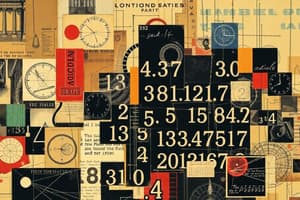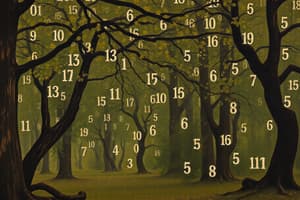Podcast
Questions and Answers
What is the result of the expression: $2 + 3 × 4 - 5$?
What is the result of the expression: $2 + 3 × 4 - 5$?
- 7
- 15
- 11 (correct)
- 9
Which of the following is an irrational number?
Which of the following is an irrational number?
- π (correct)
- -2/3
- 0.75
- √9
What is the perimeter of a rectangle with a length of 8 cm and a width of 5 cm?
What is the perimeter of a rectangle with a length of 8 cm and a width of 5 cm?
- 13 cm
- 10 cm
- 26 cm (correct)
- 40 cm
A cylindrical container has a radius of 5 cm and a height of 10 cm. What is the volume of the container in cubic centimeters?
A cylindrical container has a radius of 5 cm and a height of 10 cm. What is the volume of the container in cubic centimeters?
If x = 3, what is the value of the expression: $2x + 5$?
If x = 3, what is the value of the expression: $2x + 5$?
Which of the following is an example of a quadrilateral?
Which of the following is an example of a quadrilateral?
A set of data has a mean of 15 and a standard deviation of 3. What is the range of values that fall within one standard deviation of the mean?
A set of data has a mean of 15 and a standard deviation of 3. What is the range of values that fall within one standard deviation of the mean?
A function f(x) is defined as f(x) = 2x + 1. What is the value of f(3)?
A function f(x) is defined as f(x) = 2x + 1. What is the value of f(3)?
Solve the equation for x: $x + 5 = 12$?
Solve the equation for x: $x + 5 = 12$?
A bag contains 5 red marbles and 3 blue marbles. What is the probability of drawing a blue marble at random?
A bag contains 5 red marbles and 3 blue marbles. What is the probability of drawing a blue marble at random?
What is the area of a triangle with a base of 10 cm and a height of 6 cm?
What is the area of a triangle with a base of 10 cm and a height of 6 cm?
Which of the following is NOT a real number?
Which of the following is NOT a real number?
Simplify the expression: (x^3)^2
Simplify the expression: (x^3)^2
What is the value of the complex number: (2 + 3i) + (4 - 2i)?
What is the value of the complex number: (2 + 3i) + (4 - 2i)?
Find the determinant of the matrix: [[2, 1], [3, 4]]
Find the determinant of the matrix: [[2, 1], [3, 4]]
In a right-angled triangle, the sine of an angle is 0.6. What is the cosine of the same angle?
In a right-angled triangle, the sine of an angle is 0.6. What is the cosine of the same angle?
Flashcards
Addition
Addition
Combining two or more numbers to find a total.
Order of operations
Order of operations
Rules for evaluating expressions using PEMDAS/BODMAS.
Rational numbers
Rational numbers
Numbers that can be expressed as a fraction p/q where q is not zero.
Variables
Variables
Signup and view all the flashcards
Triangle
Triangle
Signup and view all the flashcards
Area
Area
Signup and view all the flashcards
Volume
Volume
Signup and view all the flashcards
Imaginary numbers
Imaginary numbers
Signup and view all the flashcards
Volume calculation formulas
Volume calculation formulas
Signup and view all the flashcards
Data representation
Data representation
Signup and view all the flashcards
Measures of central tendency
Measures of central tendency
Signup and view all the flashcards
Domain of a function
Domain of a function
Signup and view all the flashcards
Probability
Probability
Signup and view all the flashcards
Sets
Sets
Signup and view all the flashcards
Complex numbers
Complex numbers
Signup and view all the flashcards
Trigonometric functions
Trigonometric functions
Signup and view all the flashcards
Study Notes
Basic Arithmetic Operations
- Addition: Combining two or more numbers to find a total. The symbol is '+'.
- Subtraction: Finding the difference between two numbers. The symbol is '-'.
- Multiplication: Repeated addition of the same number. The symbol is '×' or '*'.
- Division: Finding how many times one number goes into another. The symbol is '÷' or '/'.
- Order of operations (PEMDAS/BODMAS): A set of rules for evaluating expressions. The order is Parentheses/Brackets, Exponents/Orders, Multiplication and Division (left to right), Addition and Subtraction (left to right).
Number Systems
- Natural numbers: The counting numbers (1, 2, 3,...).
- Whole numbers: Natural numbers plus zero (0, 1, 2, 3,...).
- Integers: Whole numbers and their opposites (-3, -2, -1, 0, 1, 2, 3,...).
- Rational numbers: Numbers that can be expressed as a fraction p/q where p and q are integers and q is not zero. Examples include fractions, terminating decimals, and repeating decimals.
- Irrational numbers: Numbers that cannot be expressed as a fraction of two integers. Examples include π (pi) and the square root of 2.
- Real numbers: The set of all rational and irrational numbers.
- Imaginary numbers: Numbers involving the square root of -1, denoted as 'i'.
Basic Algebra
- Variables: Symbols used to represent unknown quantities.
- Expressions: Combinations of variables, numbers, and operations.
- Equations: Statements that two expressions are equal.
- Solving equations: Finding the value of the variable that makes the equation true.
- Inequalities: Statements comparing two expressions using symbols like <, >, ≤, ≥.
- Solving inequalities: Finding the values of the variable that make the inequality true.
Geometry
- Points, lines, and planes: Fundamental geometric objects.
- Angles: Formed by two rays sharing a common endpoint.
- Polygons: Closed figures formed by line segments.
- Triangles: Three-sided polygons.
- Quadrilaterals: Four-sided polygons.
- Circles: Set of points equidistant from a center point.
- Area: The measure of the surface enclosed by a two-dimensional shape.
- Perimeter: The distance around a two-dimensional shape.
- Volume: The measure of the space occupied by a three-dimensional object.
Measurement
- Units of measurement: Standardized units for quantifying physical quantities (e.g., meters, kilograms, seconds).
- Length, width, height: Dimensions of objects.
- Area calculation formulas for various shapes (e.g., rectangle, triangle, circle).
- Volume calculation formulas for various shapes (e.g., cube, rectangular prism, cylinder).
- Converting units of measurement (e.g., inches to centimeters).
Data Analysis
- Data collection: Gathering information.
- Data representation: Presenting data visually (e.g., charts, graphs).
- Measures of central tendency: Mean, median, mode.
- Measures of variability: Range, standard deviation.
- Data interpretation: Analyzing trends and patterns in the data.
Functions
- Relation: A set of ordered pairs.
- Functions: A special type of relation where each input (x-value) has only one output (y-value). A function assigns a unique output to each input.
- Domain: The set of all possible input values.
- Range: The set of all possible output values.
- Function notation: Expressing a function in the form 'f(x)' to indicate the output when the input is 'x'.
Probability
- Probability: The measure of the likelihood of an event occurring.
- Sample space: The set of all possible outcomes.
- Event: A subset of the sample space.
- Simple probability: Calculating the probability of a single event.
- Compound probability: Calculating the probability of multiple events.
- Conditional probability: Probability of an event given that another event has occurred.
Exponents and Roots
- Exponents: Short cuts for repeated multiplication.
- Roots: Opposite to exponents. Finds the base number when the power is known.
Sets
- Sets: Collections of objects.
- Union, intersection, complements of sets. Fundamental operations among sets.
Complex Numbers
- Complex numbers are numbers of the form a + bi, where a and b are real numbers, and i is the imaginary unit (i² = -1).
Matrices
- Matrices: Rectangular arrays of numbers.
- Matrix operations: Addition, subtraction, multiplication, etc.
Trigonometry
- Trigonometric functions (sine, cosine, tangent) relate angles in a right-angled triangle to the ratios of its sides.
- Trigonometric identities: Equations involving trigonometric functions that are true for all angles.
- Applications of trigonometry: Solving triangles, finding distances and angles.
Studying That Suits You
Use AI to generate personalized quizzes and flashcards to suit your learning preferences.




